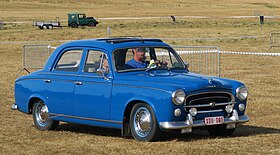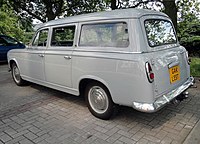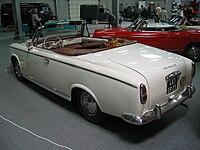Peugeot 403
| Peugeot 403 | |
|---|---|
 Peugeot 403 saloon | |
| Overview | |
| Manufacturer | Peugeot SA |
| Production | 1955–1966 1,014,111 cars |
| Assembly | France Australia [1] Argentina New Zealand (Motor Holdings)[2] |
| Body and chassis | |
| Class | Large family car (D) |
| Body style | 4-door sedan 5-door estate 2-door convertible (1956-1961) 2-door pickup[3] 3-door van[3] |
| Layout | FR layout |
| Powertrain | |
| Engine | |
| Dimensions | |
| Wheelbase | 2,660 mm (104.7 in)[4] saloon 2,900 mm (114.2 in) estate |
| Length | 4,470 mm (176.0 in) saloon 4,610 mm (181 in) estate |
| Width | 1,670 mm (65.7 in) |
| Height | 1,510 mm (59.4 in) |
| Chronology | |
| Successor | Peugeot 404 |
The Peugeot 403 is a car produced by French automobile manufacturer Peugeot between May 1955 and October 1966.[5] A total of 1,214,121 of all types, including commercial models, were produced,[6] making it the first Peugeot to exceed the one million mark.[5]
History
The 403 made its debut in saloon body style on 20 April 1955 at the Trocadéro Palace in Paris. For several months before it was launched numerous 403s, their badges removed, were circulating on the local roads near the manufacturer's PSA Sochaux factory, becoming so familiar that the locals no longer noticed them, but still attracting from Paris motoring journalists and photographers to a town that usually was of little interest to the national media.[7]
The TN3 engine size gave the car a "tax horsepower" of 8 CV (8 hp), which placed it a class below the soon-to-be-replaced 11 CV Citroën Traction, but at least one class above the small cars produced by the principal competitor manufacturers.
When it was first shown, and until after 1958, the leading edge of car's nose carried an angular, forward-leaning chrome lion bonnet ornament – the lion image being Peugeot's trade mark. That was removed for 1959, due to safety concerns, and the logo was incorporated into a shield-shaped grill emblem.[8]
Subsequently the semaphore-style trafficators on the C-pillars were replaced with flashing indicators within the light cluster. The front lights were modified to conform to new standards and in 1957 parallel windscreen wipers were substituted for the original "cross hands" ones featured at launch.
Although the car was subject to various improvements during the production run, these were mostly very minor in nature. Improvements for 1959 included moving the nozzles for the windscreen washer from the strip of metal between the base of the windscreen and the bonnet/hood a short distance to the rear edge of the bonnet/hood itself, thus presumably improving the angles at which the washer water hit the screen.[9] This was also the year that the semi-circular ring inside the lower half of the diameter of the steering wheel used to operate the horn was replaced by a full circular horn-ring, so that drivers accustomed to holding the upper half of the steering wheel did not need to loosen their grip in order to sound the horn.[9]
Design
Styled by Pinin Farina, the 403 featured ponton, three-box styling incorporating, except on the most basic models, an opening roof panel. The collaboration with Pinin Farina marked the start of a partnership which would see the Italian designer producing designs for Peugeot, including those many mainstream volume models, for more than fifty years.[7] Regarding the 403 itself there were persistent rumours that the design was one originally intended for a replacement Fiat 1900 which had been rejected when Turin had decided to defer replacement of the Fiat for another four years.[7]
Unusual in Europe at the time, but appreciated by customers, was the way that the rear doors opened wide - to a full 90 degrees.[10] Also unusual were the windows in the rear doors that opened fully into the door frame to the point where they disappeared, despite the intrusion into the door frame of a wheel arch which must have made the fit of the window when opened very marginal.[10]
Engine
The 403 came with an enlarged version of the Peugeot 203's 1290 cc petrol engine. Displacing 1468 cc, the straight-four unit employed pushrod-actuated valves and hemispherical combustion chambers and a crossflow cylinder head to produce 65 hp (48 kW) at about 5,000 rpm and 75 lb⋅ft (102 N⋅m) of torque at 2,500 rpm. An unusual feature at the time was the thermostatically controlled engine fan which cut out when the engine temperature fell to 75°C and reengaged when the engine temperature increased to 84°C.[11] Claimed advantages included an improvement in fuel consumption of between 5% and 10% according to average speed and the avoidance, under many conditions, of fan noise.[11] Another little noticed but ingenious feature involved a small hot water based heating device for the carburetor linked to the heater for the passenger cabin in such a manner that it operated only when the driver turned on the heater and not when the ambient temperature was high enough for the heater to be left off.[9]
A diesel powered Peugeot 403 estate was introduced in the Autumn of 1958, the first of a long line, followed by a diesel saloon a year later.
Upon the 203's discontinuation in 1960, a 47 hp version of its 1290 cc powerplant became available as an option on a reduced specification version of the 403, branded initially as the "403 Sept" ("7") and soon afterwards as the "403 Berline Luxe".[12] Car tax in France was based on engine size, and the smaller engined 403 fell within the 7CV taxation class rather than the 8CV of the bigger version.[12]
Transmission
The 403 came with a manual 4-speed all-synchromesh transmission[11] driving the rear wheels. The gear change lever stuck out from the right side of the steering column.[11]
For the Paris Motor Show in October 1957 the manufacturer offered, at extra cost, an electro-magnetic Jaeger automatic clutch, activated when changing gear.[11]
Interior
An unusual feature was that the front seats could be reclined to the point where the seat backs were flush with the cushions of the rear seat, thus creating a "couchette", sometimes described in English language sources, humorously, as a double bed.[9]
Body variants
The wheelbase was lengthened by 240 mm (9.4 in) for the five door Peugeot 403 "Familiale" and "Commerciale" estate versions.[12] The Familiale provided a third row of seats and was described as a 7/8 seater while the Commerciale offered a more conventional seat configuration for an estate car.[12]
The lengthened 403 estate had a solid rear axle fitted to an aluminum differential case. It came with a manual column change gearbox and, in its "Familiale" guise, fully reclinable front seats. Sunroof and steel belted radial tires were standard. Reliability was considered excellent for the time.
A two-door cabriolet version of the car was also offered, with a luxurious interior featuring high quality leather upholstery. In 1958 the 403 cabriolet cost 80% more than the entry level "berline grand luxe" 403 sedan, and presumably for this reason the convertible 403 was produced and sold only in very modest numbers.[12] In the spring of 1961 production of the 403 cabriolet came to an end, in anticipation of the launch later that year of the manufacturer's 404 Cabriolet.[12]
2-door pickup and 3-door van commercial variants of the 403 were also produced.[3]
-
Saloon side
-
Saloon rear
-
Familiale/Commerciale
-
Cabriolet
-
Pickup
Production
Superseded by the Peugeot 404 in 1960, the 403 remained in production as a budget alternative until 1966.
In addition to Argentinian and Australian production, the local Volkswagen assembler in New Zealand built 1,033 Peugeot 403s in just under four years, beginning in March 1960.[2]
Culture

On the American television show Columbo, starring Peter Falk, the shambling hero, detective Lt. Columbo, drove a shabby-looking 403 cabriolet dating from 1959 or 1960. According to the 1991 episode "Columbo and the Murder of a Rock Star", the car's cabriolet roof had never been lowered during his years of ownership. However, in the 1972 episode "Lady in Waiting" and in the 1973 episode "The Most Dangerous Match", Columbo can be seen driving the car with a lowered roof.
The 403 features in “Knife in the Water” (Polish: Nóż w wodzie) an iconic 1962 Polish drama film by Roman Polanski nominated for Academy Award. It appears from the very beginning belting along the picturesque Masurian Lake District in northeastern Poland with a whopping ~ 75 mph. A couple are rushing towards their destination accompanied by a brilliant jazz musical score by Krzysztof Komeda. When a young hitchhiker pops up in the middle of road the plot starts to thicken ...
References
- ^ Peugeot, Automobiles Australia 1960, page 199
- ^ a b Webster, Mark (2002), Assembly: New Zealand Car Production 1921-98, Birkenhead, Auckland, New Zealand: Reed, p. 73, ISBN 0-7900-0846-7
- ^ a b c 1961 Peugeot 403 Van Pickup D4 Truck Ambulance Station Wagon Brochure wu4958, www.ebay.com, as archived at web.archive.org on 9 March 2015
- ^ Gloor, Roger (2007). Alle Autos der 50er Jahre 1945 - 1960 (1. ed.). Stuttgart: Motorbuch Verlag. ISBN 978-3-613-02808-1.
- ^ a b c d Bellu, René (1997). "Toutes les voitures françaises 1956 (salon Paris, Oct 1955)". Automobilia. 2. Paris: Histoire & collections: 51, 54 & 55.
- ^ Michael Sedgwick & Mark Gillies, A-Z of Cars 1945-1970, revised paperback edition published 1993, page 152
- ^ a b c Bellu, René (1999). "Toutes les voitures françaises 1955 (salon [Oct] 1954)". Automobilia. 10. Paris: Histoire & collections: 56.
- ^ "Automobilia". Toutes les voitures françaises 1959 (salon Paris Oct 1958). Nr. 21. Paris: Histoire & collections: 41. 2002.
{{cite journal}}:|volume=has extra text (help) - ^ a b c d "Automobilia". Toutes les voitures françaises 1959 (salon Paris oct 1958). Nr. 21. Paris: Histoire & collections: 41, 44–47. 2002.
{{cite journal}}:|volume=has extra text (help) - ^ a b Bellu, René (1999). "Toutes les voitures françaises 1955 (salon [Oct] 1954)". Automobilia. 10. Paris: Histoire & collections: 57.
- ^ a b c d e f "Automobilia". Toutes les voitures françaises 1958 (salon Paris oct 1957). Nr. 8. Paris: Histoire & collections: 15. 1998.
{{cite journal}}:|volume=has extra text (help) - ^ a b c d e f "Automobilia". Toutes les voitures françaises 1962 (salon Paris oct 1961). Nr. 19. Paris: Histoire & collections: 42. 2001.
{{cite journal}}:|volume=has extra text (help) - ^ "Automobilia". Toutes les voitures françaises 1961 (salon Paris Oct 1960). Nr. 17. Paris: Histoire & collections: 44. 2000.
{{cite journal}}:|volume=has extra text (help) - ^ a b "Automobilia". Toutes les voitures françaises 1965 (salon Paris Oct 1964). Nr. 25. Paris: Histoire & collections: 44. 2003.
{{cite journal}}:|volume=has extra text (help)
External links
![]() Media related to Peugeot 403 at Wikimedia Commons
Media related to Peugeot 403 at Wikimedia Commons





